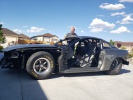Hey Gang,
Been chasing my tail trying to figure out why, what seems like a fuel cut, at high boost.
First, here is the platform and the hardware mods relevant to tuning.
2012 Cruze Ecotec 1.8 (Came NA)
Reground Stage 2 cams by Crower
SuperTech Beehive springs / retainers
10.2:1 CR
1050x ID injectors
Radium pulse damper / and fuel pressure regulator
DW300c fuel pump
Pump E85
VIM delete with custom aluminum intake manifold / LSJ throttle body
GT3582r turbo with billet wheel
3.5" intake with bellmouth w/ MAF
3" Turbo back exhaust
14 lb spring in waste gate
AEM TruBoost X controller
3 bar GM sensor
N2MB WotBox
RPM fuel cut is set to 8,192 (have done a write entire)
Have both MAF and VE tables pretty dialed in, both in closed and open loop. PE is set to .8 Lambda.
Things I have tried to eliminate the issue:
BKR7E gapped from .015-.020
4554 8's gapped from .015-.020
LS D585 coil upgrade
Tuning side of things I've tried:
Accel Thresh
Raising boost cut on fuel system to 30 psi
Adjusting max high flow psi to 88 psi
Played with timing, even pulling it down to 1-2? advance.
I'm stumped here. I've logged many runs and tried many tweaks. Attached is my current tune, and the OE tune pulled before any mods. I've also attached a run where I pull in 1st, 2nd and 3rd. As soon as boost hits 22.5 it just falls on it's face. Ideally I'd like it to hold that boost throughout until the rev limiter I've set of 8,200 rpm.
Any help or thoughts is greatly appreciated.
-Matt




 Reply With Quote
Reply With Quote


